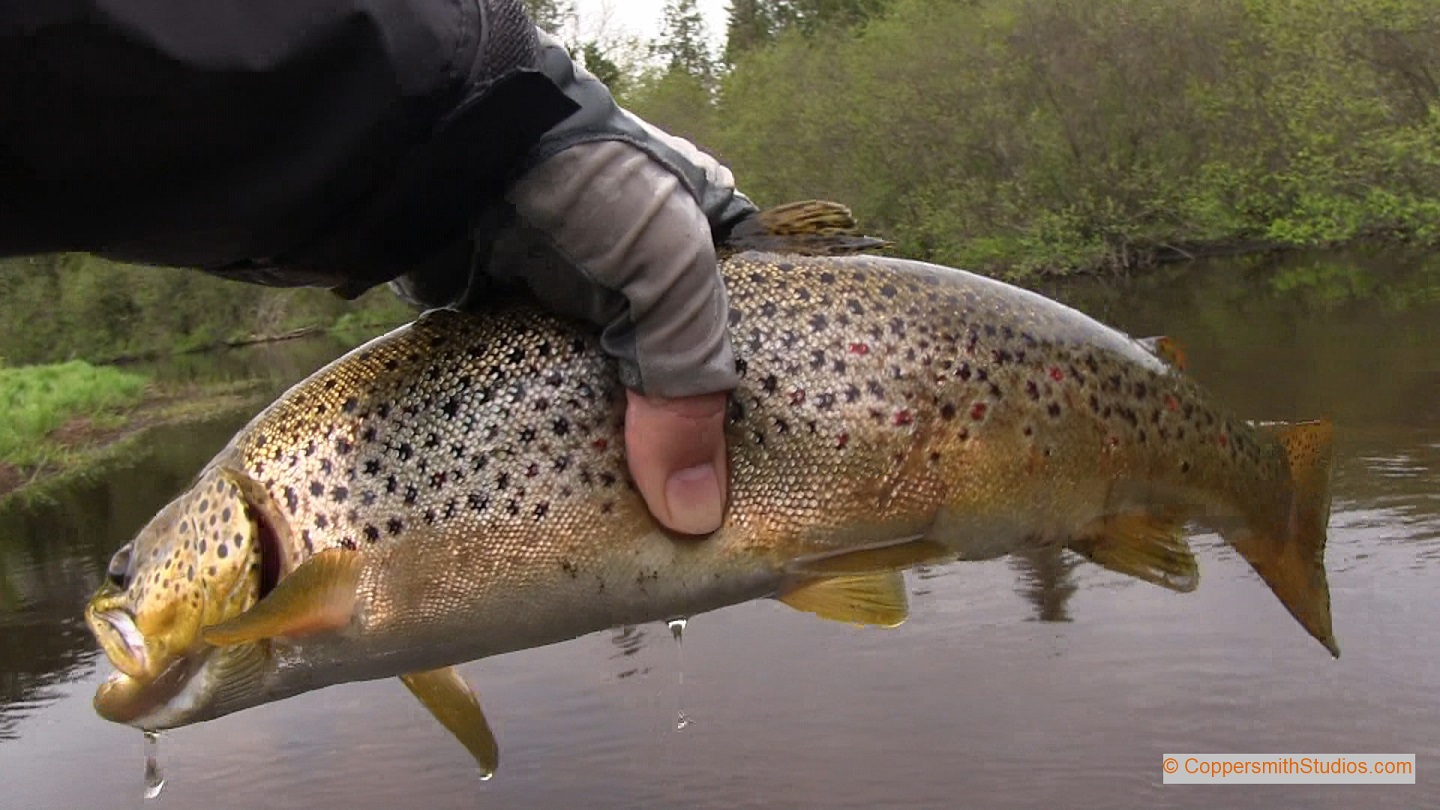 |
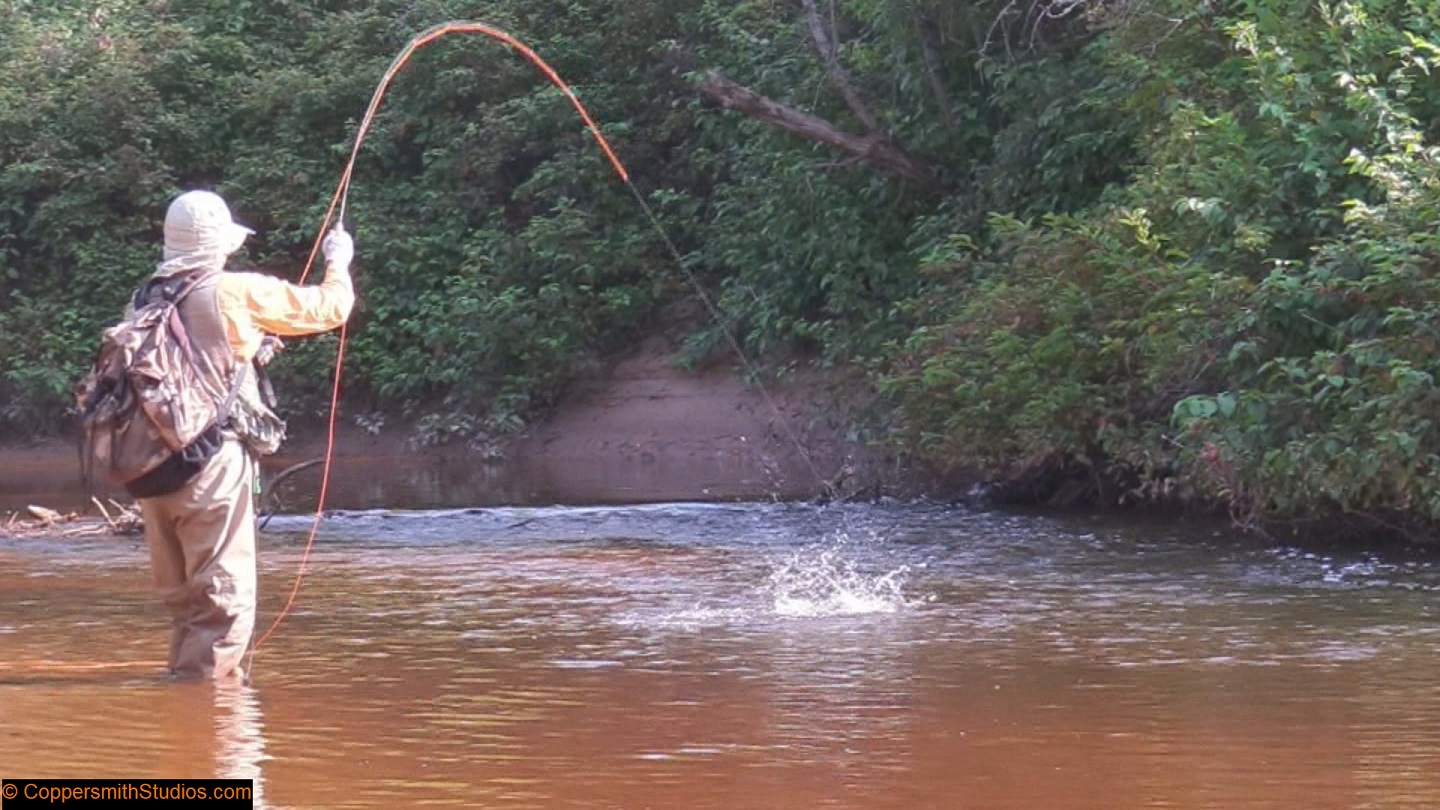 |
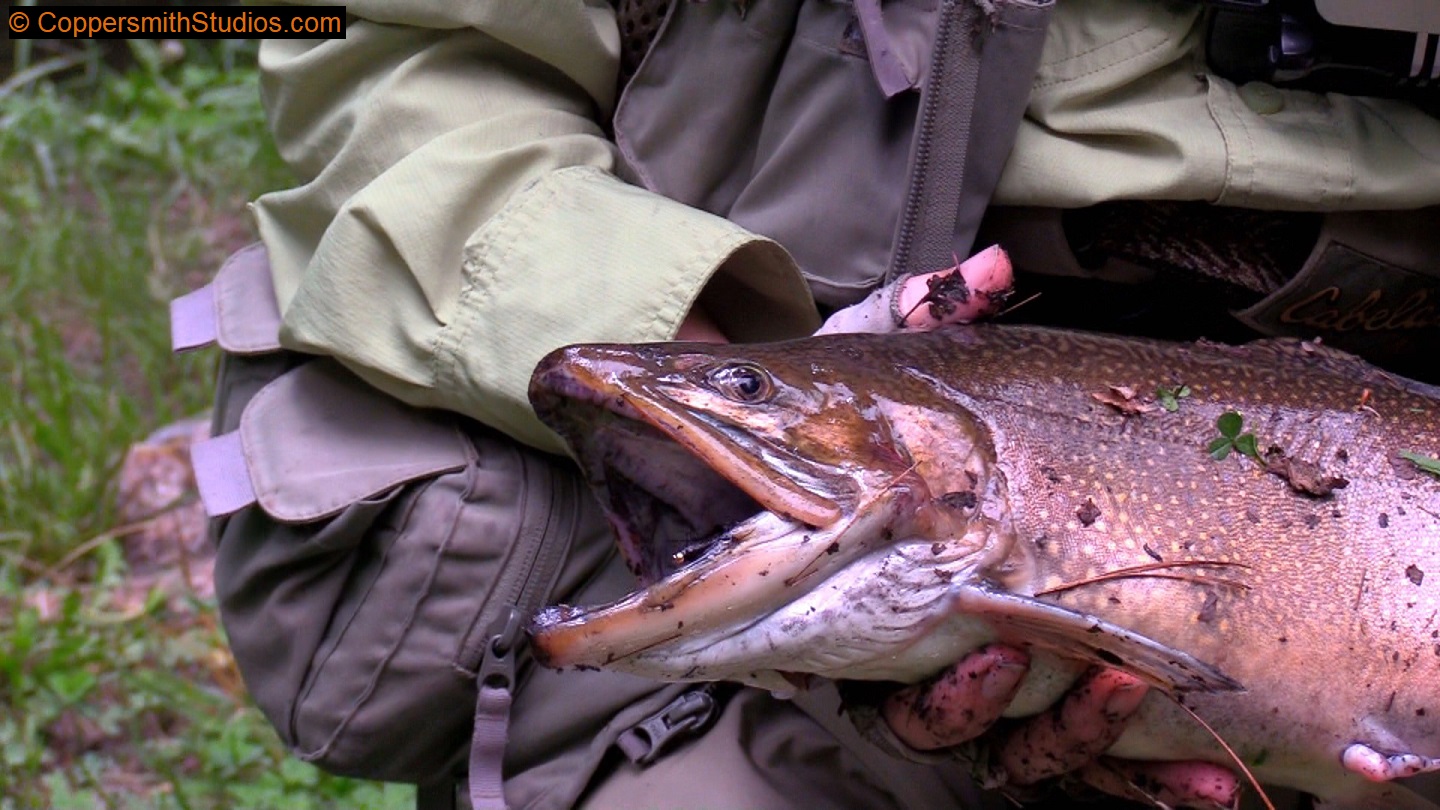 |
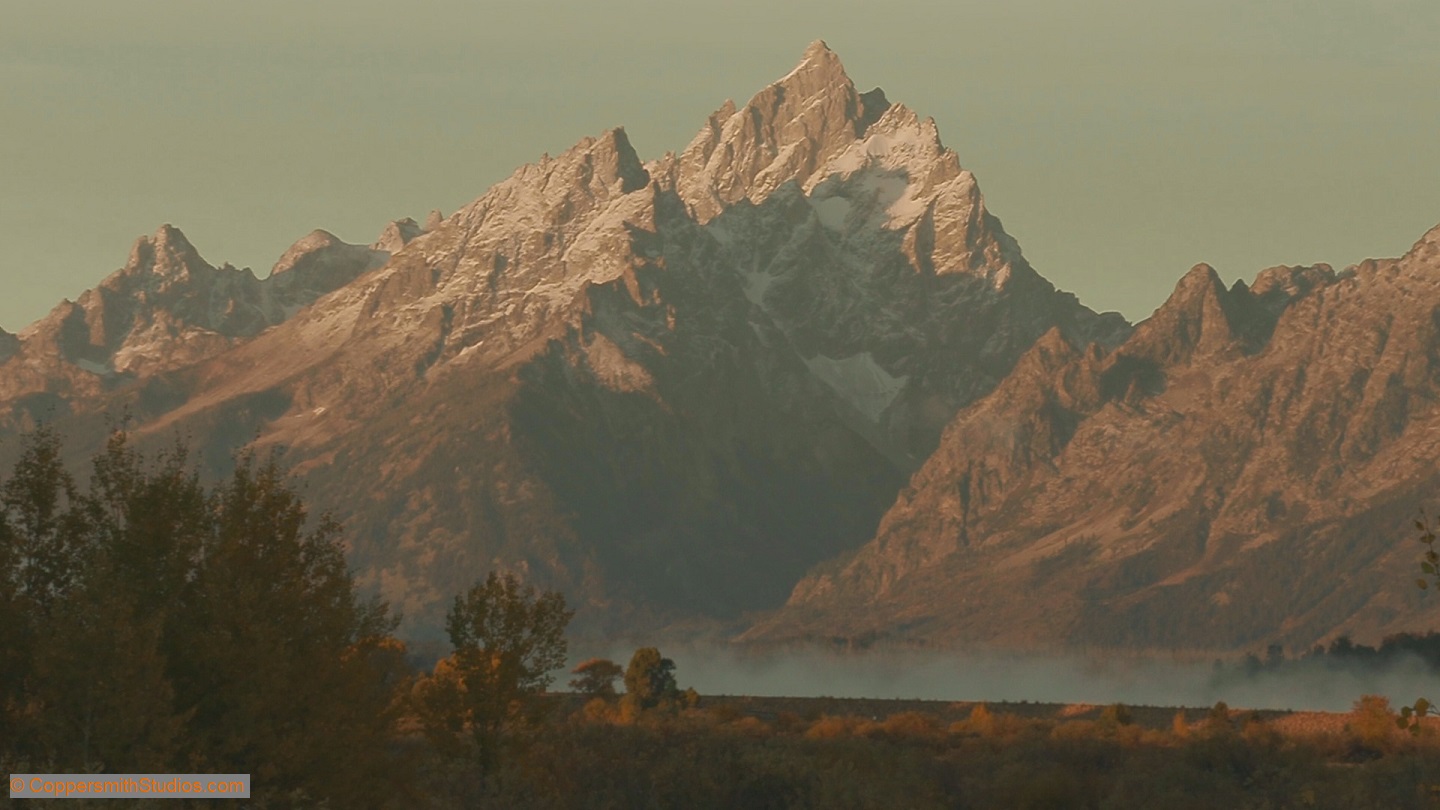 |
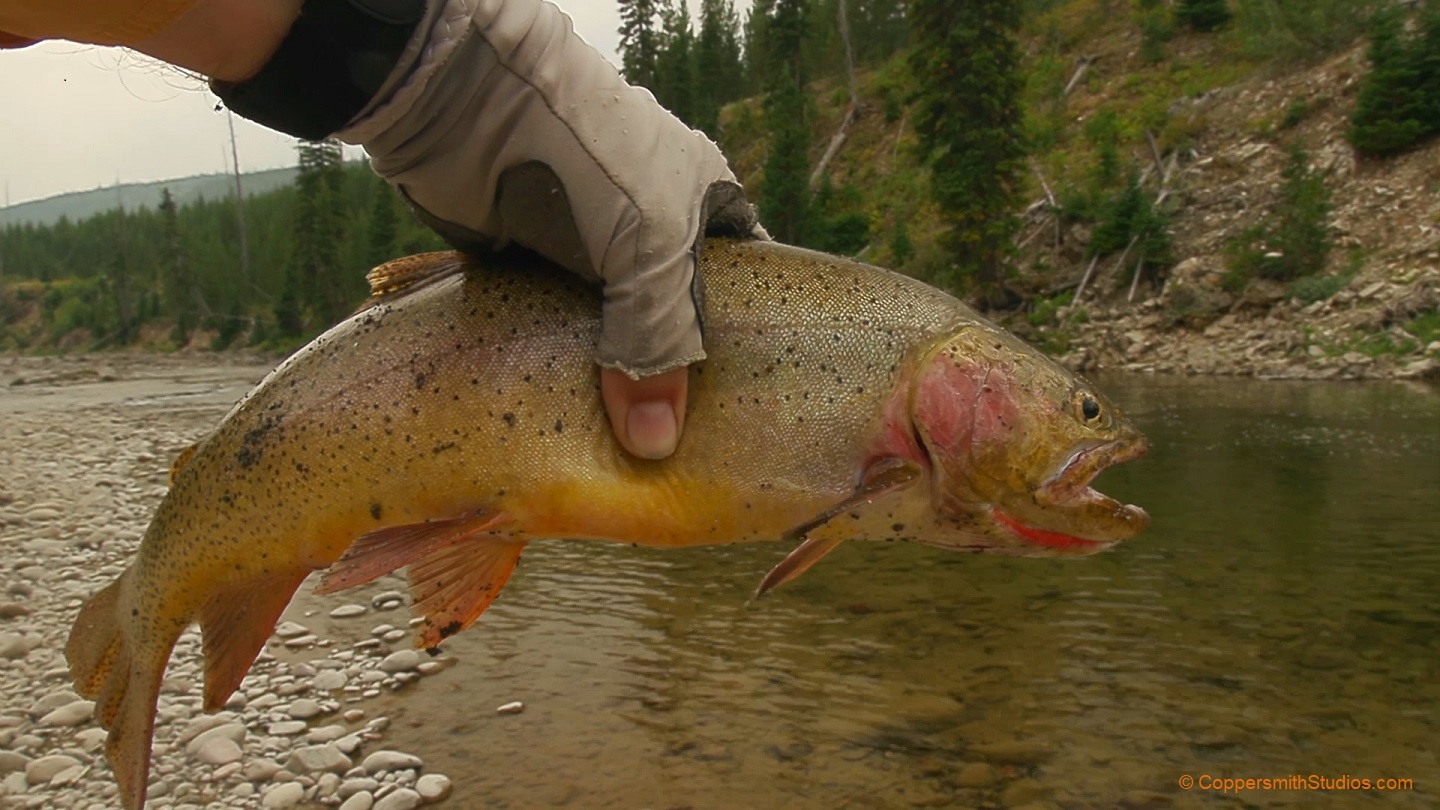 |
Stream via PATREON or CLICK BELOW TO PURCHASE.
DVD: How to Fly Fish with a Spinning Rod
DVD: Trout Streams of the Tetons
DVD: Trout Streams of Michigan, U.P. West
DVD: Trout Streams of North Carolina, West
DVD: Trout Streams of Virginia
DVD: Trout Streams of Southwest Wisconsin, North

Send Email to: CoppersmithStudios@gmail.com
Part 1: QUETICO PARK, Ontario 3 week solo fishing trip in Quetico Park, Ontario
Part 3: OGOKI RIVER, Ontario 5 week solo fishing float trip down the remote Ogoki River system in northern Ontario.
ALBERTA Fishing videos of Alberta
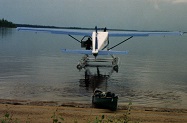 |
WATCH FIRE, MISSINAIBI & OGOKI RIVERS Slide show of my 7 week solo float fishing trip down the Fire, Missinaibi and Ogoki Rivers. |
My 3 weeks in Ontario's Quetico Park was a great wilderness adventure fishing trip, but I wanted more wilderness and more adventure. I decided upon the Missinaibi River in northern Ontario. This rugged, wild river flows 469 miles northwest from Chapleau to the Moose River, which then empties into James Bay, the southern extension of the much larger Hudson Bay. I contacted the Missinaibi Outfitters who agreed to get me to the water and then pick me up 2 weeks later.
The plan was to drop me off into the Fire River. I would float down the stream for several days until it joined with the Missinaibi. From there I would continue floating until I reached a small town at which point I would call to be picked up. The Fire River was said to be good for brook trout. The Missinaibi River was known for walleye, northern pike, sturgeon and a few smallmouth bass.
When I first called the outfitter he wanted to make sure I had a good canoe as the streams can get really rough and only a quality boat should be used. I told him my canoe was made by Old Town, which he said was a good manufacturer so I should be OK. It was only after I arrived at their location that I realized there was a major misunderstanding. He assumed I had a durable plastic canoe. My Old Town was made out of fragile fiberglass. While this is a great material for fishing lakes it is nowhere near strong enough for the powerful rapids and unforgiving boulders of the Missinaibi. Fortunately they had a spare ABS plastic canoe I could rent.
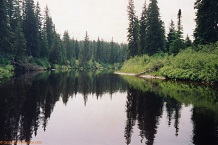 |
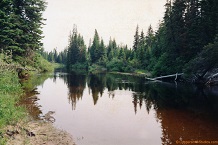 |
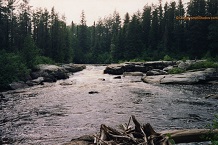 |
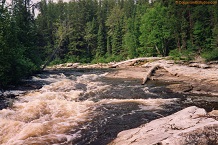 |
| Fire River | Brookie rising on the Fire River | Fire River rapids | Time to portage |
The trip began with a long drive over pot-holed logging roads until we finally arrived at a small bridge crossing the Fire River. From this bridge to the Missinaibi River there would not be another bridge to see, nor would there be any houses or any other sign of civilization. Not many people float the Fire River so I probably wouldn't be seeing anyone until I reached the Missinaibi which usually has a few canoeists floating by on any given day. After reminding me to keep my life preserver on at all times my outfitter left me.
The Fire River was generally 20' to 35' wide with clean but very dark water. The current started off leisurely and the depth was usually a couple feet. The shoreline was lined with bushes overhanging clay banks and evergreen trees in the background. Moose could be heard walking thru the forests and sometimes venturing out into the stream to eat. As to the fishing, it was generally good. I would drift along casting small spinners across the stream and picking up brook trout with steady consistency. The size of the fish were impressive. About half were between 12" to 14". To this day, the largest brook trout I caught outside of the Fire River has been 12.5". On the Fire River I caught a half dozen in the 13"-14" range. Supposedly it is not uncommon to catch specimens up to 18" from this stream. My outfitter mentioned there was another stream he serviced, the Goat River, which was similar to the Fire River. The numbers of brook trout there were a little less than the Fire but were larger, up to 4 pounds.
My first day on the Fire River went by well. I floated peacefully along the stream catching trout, having a fresh fish shore lunch, and finally setting up my campsite on a spacious gravel bar. If the rest of the river turned out like this it was going to be a very enjoyable trip. Unfortunately, that was not how the rest of the river turned out to be. Early the next morning I came to the first rapid, a treacherous mass of thunderous whitewater that threatened death to anyone foolish enough to attempt running it. It was then I realized just how remote this stream was - there were no portage trails! Trying to carry a canoe on your shoulders thru the thick vegetation of northern Ontario is no easy feat, even if it is only for a short distance. And trying to unload and reload the canoe by oneself along the slippery clay banks was also a challenge. With a second person the whole ordeal would go much faster but I was alone. After that rapid I drifted, paddled and fished a bit more until I could hear the roar of the next upcoming rapid. So again I had to portage, and again and again.
As evening approached I looked forward to the opportunity to setup my tent and have a good nights rest. However, the terrain in this area made finding a decent campsite a most difficult task. The bushes and evergreen trees take up most of the land in this area. A machete would have come in handy, as would a fly swatter. The mosquitos and black flies were fierce. Fortunately I brought my head net and a large supply of insect repellant.
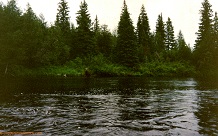 |
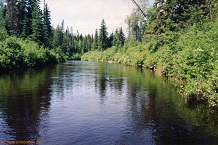 |
 |
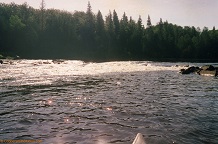 |
| Fire River moose | Fire River | Scouting the rapids | Missinaibi River, Twin Rapids |
The third day was basically a repeat of the second. When I took time to fish I would have decent action on nice sized brook trout. I would clean and cook the fish from the confines of my canoe as there were no convenient places to do that along the shoreline. Then it was on to the next rapids and the next portage. During the portage the center cross thwart in the canoe cracked. From then on I had to drag it along the portages. As heavy and cumbersome as it may have seemed on my shoulders it was far worse having to drag that thing on the ground.
On the fourth day I realized I was seriously falling behind schedule and needed to do everything possible to increase my speed. I initially estimated the total distance down the Fire River to the Missinaibi was 50 miles. I later learned it was 80. I also had no idea there would be so many portages and that they would take so long. In between rapids the river was getting slower and slower, requiring me to paddle that much harder. When I would fish I would get hits but had trouble hooking the fish. Back then I didn't fly fish. Had I known then what I know now I surely could have easily enticed some of those short striking brookies into a solid hook set. I finally did catch one, a hefty 14" fish that I promptly put on my stringer and then threw it back into the water while I got my cooking gear ready. I then realized I never tied the stringer to the canoe! That night I ate no fish.
The fifth day I did nothing but paddle and portage as hard as I could. I should have been in the Missinaibi River by now but still had a long ways to go. I started getting reckless and began running rapids that normally I would have portaged. I spent a good amount of time scouting them and figuring out the best route, then debating for a while if I should run it or not. A couple rapids I ended up walking my canoe down them and even then it nearly got away from me and almost capsized. That night I was a little slow in closing my tent door and it filled up with black flies. I killed over 500 of them but the main nuisance was the mosquitos.
The 6th day was again a mad dash to get out of the Fire River as fast as possible. There was no time to fish. One of the water falls I portaged around was a good 30' high, somewhat reminiscent of the upper falls on the Yellowstone River. I regrettably did not take a picture. This was all repeated on the 7th day. So I was exerting myself all day long and had gone 4 days in a row without any fish to eat. This was starting to remind me of my trip to Quetico.
On the 8th day I finally reached the Missinaibi River. Hurray! The confluence of these two rivers has some interesting fish history to it. After the last rapids on the Fire River there is about a mile of water before the confluence. This mile is known to produce large smallmouth bass up to 6 pounds. I saw photos of some of these fish and they did look rather big. But that is really nothing compared to "the hole" which is formed where these two rivers meet. The depth here is 80 feet. More impressive is the size of the fish residing in these depths. It is said that monstrous northern pike up to 100 pounds prowl these waters. To catch such a leviathan, it is recommend you first catch a normal sized northern pike, at least 4 pounds or larger. You will need to impale it with an extra large hook. Next, find a big chunk of drift wood to use for a bobber. Now, toss the whole thing into the hole and hold onto your rod. (note: fishing with game fish as bait is technically illegal in Ontario. I did not perform any such action as I couldn't even catch a small pike here and am not recommending you do this.) I spoke with a reliable source who had fished the hole a number of times and twice hooked the monster pike. Both times he was able to get a good enough look at the behemoth to judge its size. Both times the fish eventually got away, tangling the line in some underwater snags.
Before I continue with the Missinaibi River, let me clarify my attitude about the Fire River. Yes, it was difficult as Hell. I was exhausted, famished, and ornery because I was working hard all day without even having time to fish. Nonetheless, it was a pristine, beautiful wilderness river fished by only a few and yielding brook trout larger than any I had caught before or after. A stream like this needs to be fished by two people and they should bring a machete. That would make the portages vastly easier and faster. I underestimated the mileage and total time to travel it and ended up paying the price. Ultimately I have to give this river a good rating as a destination fishing stream, but if you are going to fish it you need to do it right.
 |
 |
 |
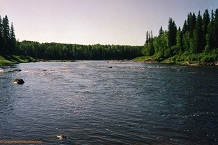 |
| Pond Falls Rapids | Below Pond Falls Rapids | 34" 12 pound pike | Devils Rapids |
I fished the Missinaibi/Fire River confluence thoroughly with puny little 3/4th oz Syclops and Daredevle spoons and caught nothing. I then trolled for several miles downstream and caught nothing. The section of river for several miles remains deep and slow. When I finally reached a rapids I got out my ultralight and caught a 15" fall fish on a jig. Fall fish are a type of chub common to that region and can sometimes be caught on small artificial lures. Regarding fall fish, Wikipedia states: "... opinions vary as to its edibility." It had been 5 days since I had a fish dinner and with all of that paddling and portaging I was getting thin again. I put the fall fish in a pot and tried cooking it. The weather had become very cold that day, only about 50 degrees, and my little can of Sterno wasn't able to heat the water to the boiling point.
The next couple days I spent most of my time paddling, not fishing. I continued to struggle to make up all of the lost time from my delays in the Fire River. When I did fish I didn't catch anything. It rained extensively and was generally cold. I hadn't brought enough warm clothes to deal with the mere 50 degree highs this region can experience during the summer. The rapids here were big. I ran several of them and it was exhilarating. At least now the rapids that were too dangerous to run had portage trails along them. And I didn't worry too much about when the rapids were going to come. There are maps available that tell you exactly when to expect a rapid, what the rating is, which direction to run it or what side to portage around it.
There was one rapid that got really dangerous. The section gradually increased in intensity with a number of boulders sticking out of the water until it finally climaxed in a 3 foot water fall. I tried to canoe as far as I could into the rapid staying close to the shoreline with the intent of getting off the river before the final plummet. My canoe hit a boulder and turned crosswise to the current. The water rushed fast under the canoe, pinning it against the rock and tilting it so the gunwales were just an inch above the water. One more inch and that river would have swallowed up my canoe and wrapped it around that big granite boulder like a candy wrapper. The bigger problem is that I was not in a candy store. There were no roads nearby, no cell phones, no anything except a rendezvous point several days of hard paddling further downstream. With precious little time I gave a push off the rock with my paddle but the canoe would not budge. Realizing I had just 2 seconds left before complete obliteration within the mighty Missinaibi I gave one final desperate heave and miraculously the canoe slid around the rock and remained upright, taking in just a couple inches of water. I got to the shoreline as fast as possible and portaged the remainder of the rapid. That was a close one.
 |
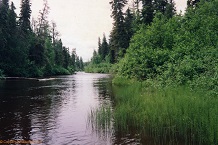 |
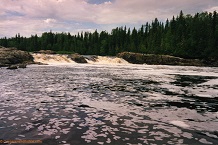 |
| Missinaibi River below Albany Rapids | Shetland Creek (tributary to Missinaibi) | Glassy Falls |
I finally caught several smallmouth bass around 14" below the Pond Falls rapids. And yes they tasted good. The next day I had a fun time zig zagging and dodging boulders thru the 2 mile long Albany Rapids. At the base of this rapid is a 5 foot drop over a ledge spanning the width of the river. I setup my campsite on a large rock slab at the base of the rapids and caught a dozen walleye fishing from shore. They all hit a 1/4th oz black twister tail jig just as it passed from the current into the eddy caused by the rock slab. I caught the first 10 in about 12 casts and then a few more after that. All but 2 were between 15"-20". And yes, they tasted really good. When I took a cast into the slack water near the shoreline I hooked into a 34" northern pike. He registered 12 pounds on my scale. I was fortunate to have hooked him in the corner of the mouth otherwise those razor sharp teeth would have probably bit off my leaderless jig. So finally, after all of the effort and struggle and disappointment, I had a really good moment of fishing on the Missinaibi.
The next morning I was able to catch a couple more walleye for a shore breakfast and a few nice pike from the shoreline eddy. There appeared to have been a lot of northerns stacked up in that eddy but except for a couple I had difficulty enticing them to hit my spoon. Apparently they were already well fed. I spent the remainder of the day mostly paddling, taking only a little time to fish an occasional spot. I did this the day after and the next until finally I reached the take out point. From the local grocery store at the small town I called my outfitter to request him to pick me up. When he finally arrived he expressed relief that I had successfully survived the 15 day long ordeal, especially considering it was my first big Canadian river trip and I was alone. Well, as difficult and dangerous as that trip was it would be out shadowed by my next stop: 5 weeks on the Ogoki River!
Created by: Dan Coppersmith 2023| www.CoppersmithStudios.com